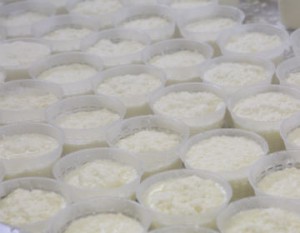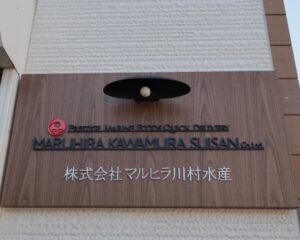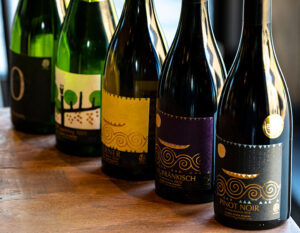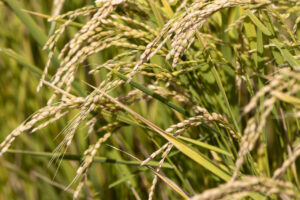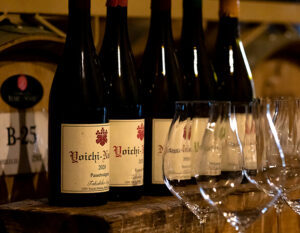In Hakodate City, Hokkaido, blessed with rich fishing grounds,
Minami-Kayabe Fishery Cooperative Association continues to preserve the taste of “Tenka Kombu”, which has been loved since time immemorial.
To pass on the kelp that supports Japan’s food culture to the next generation, we stick to traditional production methods and
deliver high-quality, delicious kelp.
Kombu dashi is an essential part of Japanese cuisine, with its beautifully clear golden color and fragrant aroma. Its finest product is located in Hakodate, Hokkaido. The high-quality kelp, named “Hakodate Makombu,” was once presented to the Imperial Court and shoguns as a gift kelp. We asked the “Minami-Kayabe Fishery Cooperative Association” about the past and future of kelp fishing.
Hakodate Makonbu, the highest quality kelp grown in the rich sea
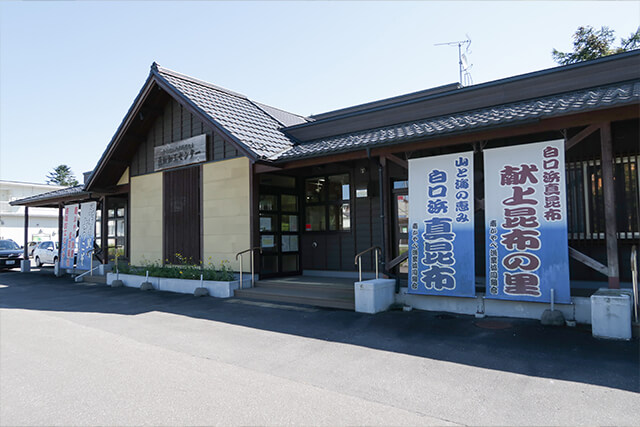
Dashi” is an indispensable part of Japanese cuisine. Kombu dashi has a particularly long history, appearing frequently as a seasoning in practical cookbooks from the early Edo period (1603-1868). To learn more about kombu, which has long supported Japanese food culture, we visited Minamikayabe, Hakodate, Hokkaido.
Minami-Kayabe’s kelp fishery boasts Japan’s largest production volume
The Minami-Kayabe region is located in the eastern part of Hakodate City, Hokkaido, facing the Pacific Ocean’s Eruption Bay. Nutrient-rich river water flows in from the forests, and offshore, the warm currents of the Tsugaru Straits intersect with the nutrient-rich cold Oyashio Current. A rich fishing ground has been formed and the area has developed as a fishing village since ancient times. Various seafood such as squid, salmon, and yellowtail are landed here, and the area boasts the largest production of kelp in Japan.
In Hokkaido, a major kelp-producing region, kelp is landed in Rishiri, Hidaka, Rausu, and many other areas. Hakodate Makonbu, harvested in Minami-Kayabe, is especially thick and wide, and is called the finest kelp for its clarity and elegant flavor in soup stock. In the Edo Shogunate’s survey report on Ezo Island, “Ezo Shima Kikan,” it was described as “k elp under heaven” and “the finest kelp ” and was once presented to the Imperial Court and shogunate.
Why does Minami-Kayabe produce such high quality kelp? We asked Mr. Hidefumi Sakai, counselor of the Minami-Kayabe Fishery Cooperative Association, about the reason.
The broadleaf trees and volcanic rocks in the forest have a positive effect on kelp.

Geographically, it is a very blessed place,” he said. Silicon is essential for the growth of kelp, and this coastal area is made of rhyolite, a volcanic rock that contains a large amount of silicon. In addition, the confluence of the Oyashio and Tsugaru Warm Currents maintains a water temperature suitable for kelp growth. The forests that surround the sea are rich in broadleaf trees, and the water that flows from the rivers into the sea is rich in minerals and nutrients, which also has a positive effect on the kelp.
In addition to harvesting natural kelp, the company began cultivating kelp in the 1960s, and has been able to maintain a stable production.
From “catching” to “raising. Invention of an epoch-making cultivation method
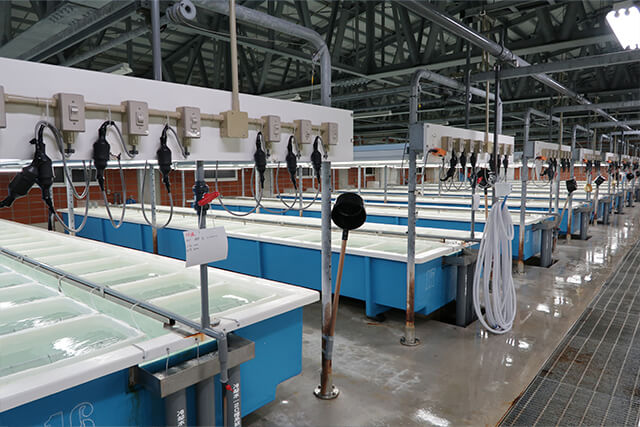
The beginning of kelp cultivation brought about a major change in the local fishing industry.
In the beginning, kelp was thought of as a supplement to the stable production of natural kelp, but after 10 years of cultivation, the situation was reversed, and kelp cultivation became a major industry in the region.
The shift from “fishing to catch” to “fishing to grow” has made cultured kelp the top producer of kelp in the region, and it has finally become the “top producer of kelp in Japan.
If aquaculture technology had not been developed,” Sakai says, “the number of fishermen in the region would have been much smaller and the local economy would have been devastated.
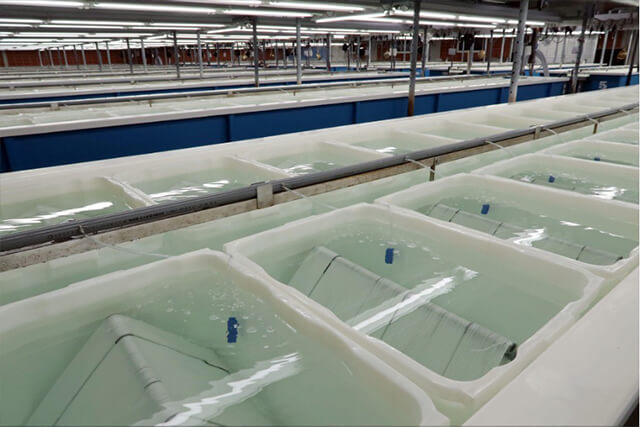
Cultured kelp is cultivated at seedling production facilities after the mother algae (bosou) is harvested from natural kelp. Once the seedling threads (kelp seeds attached to the threads) are ready, they are sent to an offshore aquaculture facility. The seedling threads are tied to ropes called training nets and allowed to grow in the sea. Normally, it takes two years for both natural and cultured kelp to grow, but in Minami-Kayabe, the harvesting period has been successfully shortened through early seedling collection and the provision of sufficient nutrients.
This method is called “accelerated kelp cultivation,” and it takes about 10 months to harvest the kelp. Minami-Kayabe also produces some kelp that is cultivated for two years, but the main focus is on the accelerated cultivation method. The ability to harvest kelp without waiting two years is a big advantage in aiming for a stable supply.
What is the difference between natural and cultured kelp?
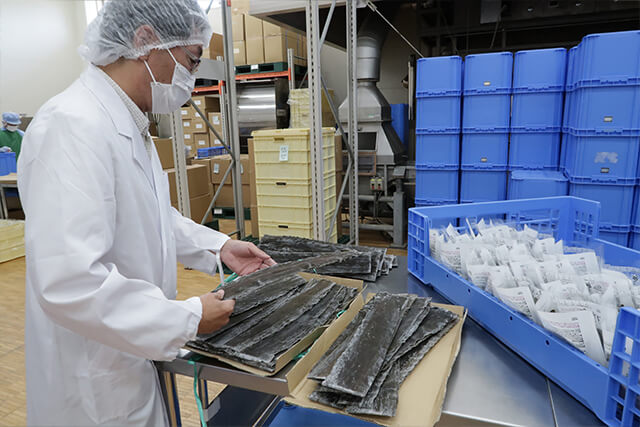
What is the difference between natural and cultured kelp?
Natural kelp has its roots in the ground and grows upward. Cultured kelp, on the other hand, takes root in a rope and grows downward. Natural kelp is slightly thicker than cultured kelp, but some two-year cultured kelp is wider and more splendid than natural kelp,” Sakai told us.
When laid out in their dried state, there is no significant difference in appearance, and it is difficult to tell them apart. However, when you take the broth, there is a clear difference. The natural fish is a light golden color with a sense of transparency, while the cultured fish is a little less transparent and darker in color. Also, even with cultivated kelp, the color of the broth is closer to that of natural kelp when the kelp is two years old rather than when it is matured.
As for the difference in taste, while the dashi from the promoted kelp has an immediate umami taste in the mouth, the natural kelp is lighter in the mouth, but the umami taste can be felt gradually in the back of the tongue and throat. On the other hand, when eating the kelp itself, cultured kelp is softer and less sticky than natural kelp, making it easier to eat.
Natural kelp is used for Japanese soup stock, while cultured one-year kelp is softer than natural kelp, so it is recommended for use in soup stock and in dishes where kelp is eaten as is, such as kombu maki (kelp rolls). Cultured 2-year-old fish is relatively similar to wild caught fish, so it may be better to use it for making dashi broth,” says Sakai.
It is not a matter of which is better, natural or cultured, but rather, it is a matter of choosing the right one for the right purpose. In recent years, however, natural kelp has become extremely rare and the market price is more than three times that of cultured kelp.
The sea in Hakodate has changed. Natural Kelp Continues to Decline in Landings
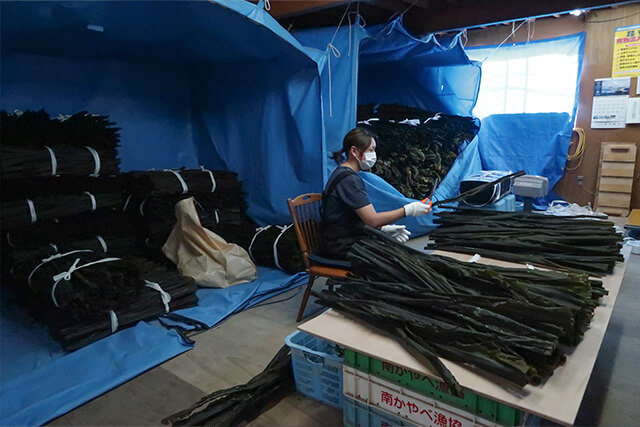
After peaking in 2014 with a good harvest, the amount of landings of natural kelp has been drastically decreasing every year. The catch, which used to be 700-900 tons, was only about 5 tons last year (2021) due to various factors such as typhoons, bombing storms, and abnormal breeding of sea urchins that prey on kelp caused by rising sea water temperatures.
Sea urchins are cultivated by taking seeds from natural kelp, so if the natural kelp disappears, the sea urchins can no longer be cultivated. Divers are taking measures such as weed control in the fishing grounds and the formation of seaweed beds, but they have not been able to increase production.
Twenty years ago, if you looked at the ocean, you could find kelp everywhere. But in the last few years, natural kelp has not grown at all. In fact, we don’t know exactly what the cause is. Is it global warming or are there other factors? But we do know that the sea is different from what it used to be,” Sakai frowns.
Protecting kelp means protecting Japan’s food culture
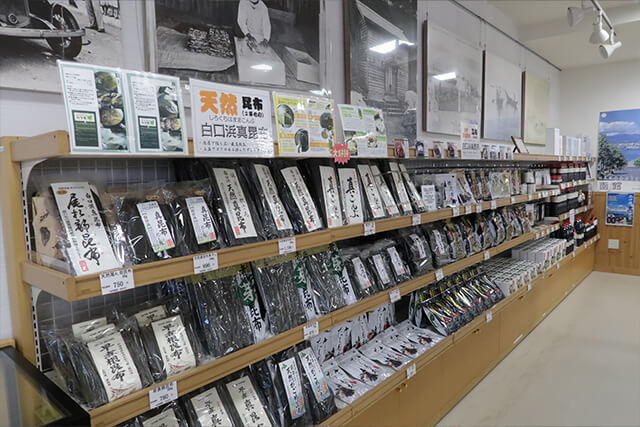
Sakai and his colleagues at the Minami-Kayabe Fisheries Cooperative Association are continuing their battle against the natural environment to increase the production of natural kelp, while also focusing on strengthening the brand power of Hakodate Makonbu.
While other Hokkaido kelp, such as Rishiri kelp, Hidaka kelp, and Rausu kelp, are named after places, makonbu has not had a regional name for a long time. Therefore, several years ago, the name of the local kelp was unified as “Hakodate Makonbu. The company is also actively engaged in PR activities to connect the production area with consumers, such as exhibiting at product fairs and giving lectures.
Natural kelp production has been declining due to changes in the natural environment. However, not many people are aware of this. Mr. Sakai believes that it is important to appeal to consumers with a sense of crisis.
Mr. Sakai and his colleagues will continue their efforts to keep the history of Minami-Kayabe, which has been developed together with kelp, alive and well, and to continue to support Japan’s food culture.
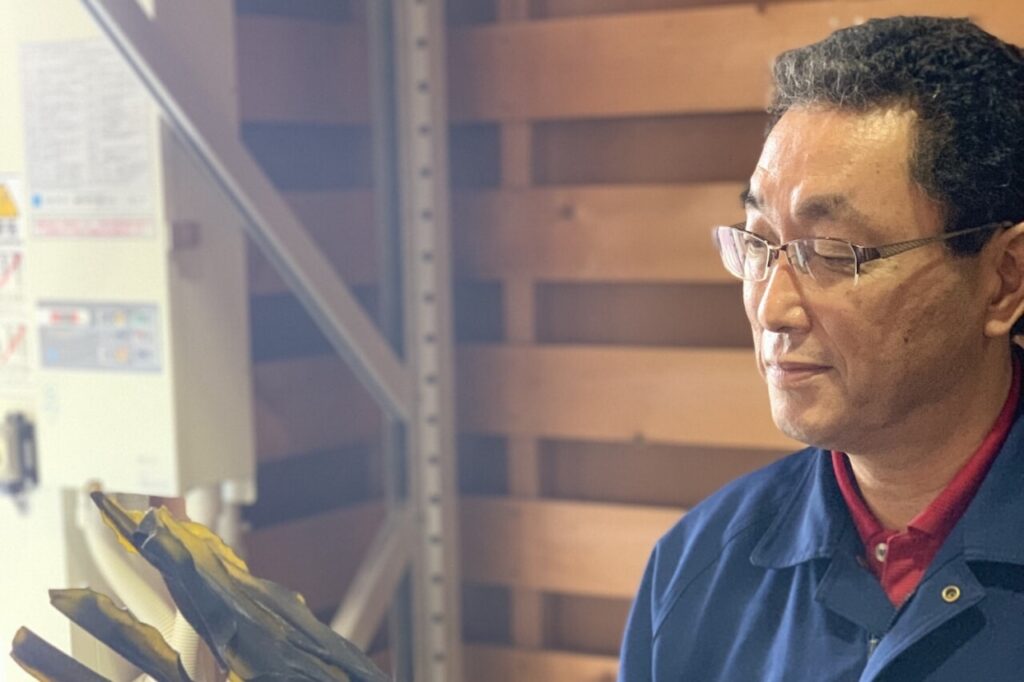
Makonbu (Japanese kelp) has long supported and been a part of Japan’s food culture. It is an excellent ingredient in its own right, and is a finished product. We feel that our mission is to bring out the best of the original taste of Makonbu without any unnecessary modification.




